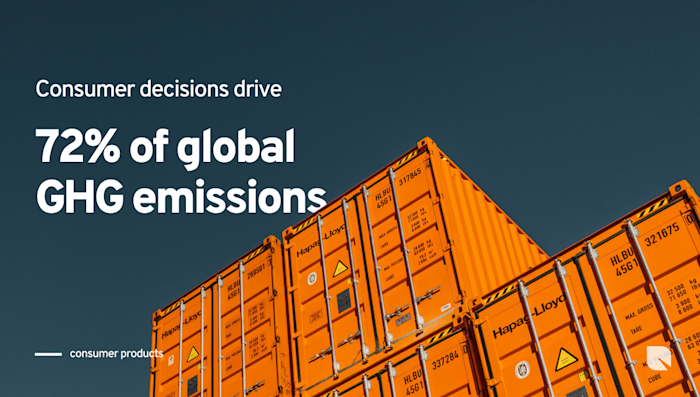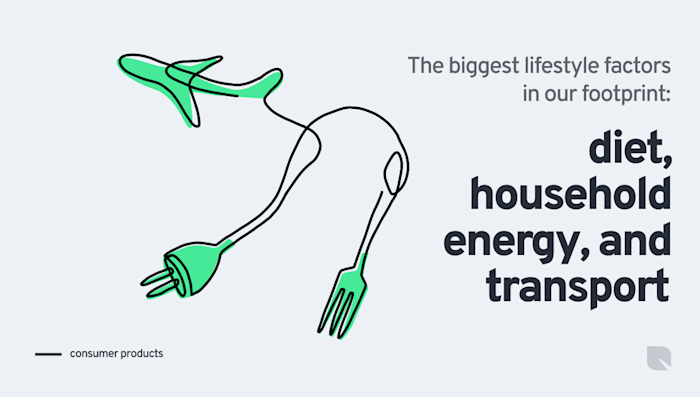Green lifestyle: a brief introduction
A green lifestyle can help you conquer your climate impact – and a huge part of that is minimizing your carbon footprint. This article outlines how.
A green lifestyle is a means of harm reduction: Living your life in a way that demands the least resources from our planet. Often, this starts with being conscious of your carbon footprint: the amount of carbon dioxide you make. But if you think this stops at carbon you directly release — from your gas stove, or tailpipe — think again. Commonly, your carbon footprint refers to the carbon dioxide you’re responsible for.
Basically, everything has a carbon price: the amount of carbon dioxide produced at every link of the supply chain to get that desk into your office, or that food onto your plate. It doesn’t even have to be physical. That email you just sent? It has a carbon weight (estimated around 4 grams, if you’re wondering). Think about it: Emails need electricity to send, as do the servers that store them.
Thanks to decades of rampant consumerism and climate indifference, the typical Western lifestyle — with our personal cars and big houses and overbuying and red meats and single-use plastics and all-day AC and wasted food — is groaning with carbon. So leading a green lifestyle is a conscious, against-the-grain effort. But it’s worthwhile. Not just for the planet, but for you too!
Why is a green lifestyle important?
The planet is on a dangerous climate trajectory. With global temperatures rising and natural resources dwindling, we’re dancing ever closer toward the cliff edge. Correcting this course requires both ‘them’ (governments and corporations) and ‘us’. The latter is just as important. With consumer decisions driving 72% of global emissions, our lifestyle habits will ultimately script our planet's future.

A green lifestyle: the big decisions
So, you're amply pumped and want to take an axe to your carbon footprint? Cool. Let's start with the macro stuff: your diet, your home, and your transport.
You are what you eat. Ever heard that phrase? Turns out, so is your carbon footprint. Livestock represent 14.5% of greenhouse gas (GHG) emissions. Of that, 61% comes from cattle alone (41% beef and 20% milk production). The lesson is clear: Buy less red meat and dairy. White meats pose an alternative. Chicken creates 7.2 times less GHG emissions per kilogram than beef. But if you want to go for gold: Vegetarian or vegan diets slash your footprint — sorry carnivores.
Your home offers a close and effective way to green up. 20% of GHG emissions in the US come from residential energy use. So energy-efficient households sit high on the priority list for a sustainable future. Our Klima Guide dishes on how to help here, but basically: Go easy on the thermostat and properly insulate your home. There’s a financial benefit too. Homeowners can save around 15% on energy costs with air sealing and insulation.
The last of the ‘big three’ is transport. 12% of worldwide GHG emissions comes from road transport, and if global aviation were a country, it would rank in the top 10 emitters. This is perhaps the trickiest area to clean up, as some flights or drives are simply unavoidable. Nevertheless, our Klima Guide covers five ways to roll back your footprint here — from carpooling to biking!

A green lifestyle: the small tips
There are endless ways to sand down your footprint. That’s not hyperbole. Literally endless: Everything you do or use could be replaced with something better for the environment. So let your creativity shine. Here are a few examples to get you started!
Enjoy a staycation every now and then.
Put organic waste in a compost bin.
Got a recycling bin? Use it.
Buy goods that are certified sustainable. Bonus points if they're made from recycled materials.
Don’t throw batteries in the trash (they leak harmful chemicals).
Repair broken, worn, or torn things.
Reuse containers and plastic bags.
Reuse belongings, or donate them to loved ones or charity.
As you may have noticed, all these tips are petals of one core philosophy: Use less, reuse, and recycle. But in order to be meaningful, they should supplement the main reductions (diet, energy, and transport) discussed earlier. Otherwise, you're just chipping your carbon footprint, not chopping it.
The many dividends of a green lifestyle
Strip away all the environmentalism, and a green lifestyle means being thrifty, discerning, and a little crafty. But that just happens to be the perfect recipe for saving money. In fact, you could basically rename this article ‘how smart consuming saves $$’ and have the same content. This alone should add weight to the green cause: It’s better for the environment and your bank account.
Some think a green lifestyle means throwing off the shackles of modernity, returning to nature, and living in a treehouse. And heck — if you’re into that, we won’t stop you. But the climate crisis is stimulating new technology for sustainable solutions. Make use of them! As much as reducing what you buy is important, sometimes replacing something carbon-heavy (your traditional car) with something carbon-light (an electric car) can make a huge dent in your carbon footprint.
Indeed, as you slide into a green lifestyle, you might ponder why the carbon-light option is almost always the healthiest. Chicken over beef. Fresh over prepackaged. Biking over driving. We like to think of these as the benefits package when you live alongside nature, not against it.
Green lifestyle vs global warming
The global climate is warming, and demands intervention. But while human activity dug us into this crisis, it can also dig us out. Individual climate action is the philosophy powering the Klima app. Our smart technology learns about your lifestyle, offering tailored tips to reduce your footprint to its minimum. And what you can’t reduce, we’ll offset with powerful, handpicked offsetting projects. Minimizing and offsetting squashes your carbon impact from both ends — laying a high-quality path toward a green lifestyle. Let Klima show you the way here!



